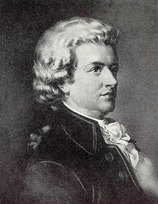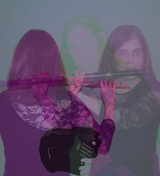Rondo for Violin in C major, K. 373
Rondo for Flute in D major, K. Anh. 184 (transposition of K. 373)

Wolfgang Amadeus Mozart was born in Salzburg on 27 January, 1756, to musical parents. He was a phenomenally precocious child prodigy, a “wunderkind”. Talented at the piano, violin and viola, he had composed over 600 works, including operas, symphonies, and chamber music, by the time of his tragically early death at the age of thirty-five. He was friends with Haydn, a protégé of C.P.E. Bach and an inspiration to many, including Schumann and Mendelssohn.
Mozart lived during the “age of enlightenment”, when Rousseau was encouraging his fellows to cast off their chains and Thomas Paine was developing his “Rights of Man”. There was a new interest in free intellect and introspection. Mozart’s instrumental music was particularly reflective, prescient of Romantic music. While this was a fertile and creative time, patronage of the arts was in decline. The Hapsburg ruler Joseph II’s focus was firmly on socio-political priorities, and pecuniary difficulty was a common theme throughout Mozart’s life. Unlike Haydn, who benefitted from a long-term relationship with his patrons, Mozart had a tumultuous relationship with supporters and his livelihood was based in his performance skills.
The Rondo for Violin in C major, K. 373 was composed in April, 1781, shortly after Mozart took up permanent residence in Vienna. The epitome of stile gallant, the rondo is Allegretto grazioso, moderately fast and graceful, aristocratic and elegant. It was almost certainly composed for Antonio Brunetti, the celebrated Italian virtuoso violinist, although, in a letter to his father, Mozart referred to Brunetti as “a thoroughly ill-bred fellow”.
At first glance, the Rondo appears to be a simple piece with little complexity or musical depth. Unlike typical classical rondos, however, Mozart developed the form into the “sonata rondo”, with a plethora of melodic themes in just 182 bars. Floyd Grave’s analysis captures this:
“..the complementary phases of sonata- form exposition and recapitulation on the one hand, and the rondo’s customary rhythm of alternation between a tonic-key refrain and spans of intervening contrast on the other... Mozart manages to dovetail these two disparate principles, but also to confront the fact of their basic incompatibility ...he often seizes on that very incompatibility and derives from it a compositional resource of vast possibility. In essence, the friction generated by the simultaneous unfolding of sonata and rondo serves him as a foundation for strokes of surprise, suspense, and the wit of unsuspected relationship—and also, perhaps paradoxically, as a source of structural cohesion.” (Grave, “Mozart’s Problematic Rondos”)
The origin of the Rondo for Flute in D major, K. Anh. 184 is unclear, but it is almost certainly later than the violin work that it imitates. The two works are virtually identical. The flute cadenza is now written out, attributed to Jean-Pierre Rampal who was instrumental in popularizing the work. The violin rondo includes dual octave leaps where the flute version has just a single octave. The ending in the last bar is inverted - the violin finishes high on what would be the flute’s fourth octave C, while the flute finishes low on second octave D, a much more pleasing note.
It is a commonplace that Mozart disliked the flute, probably because of its unreliable tuning. He lived during a time of change and experimentation, when there was a moving away from the one-keyed baroque flute to innovations such as Quantz’ tuning slide, and Trömlitz’ new flute in which “in which each of the twelve semitones of the chromatic scale was produced by a separate tone hole not shared by any other note”. The Trömlitz flute’s pure (rather than tempered) intervals were in keeping with Mozart’s ideas on tuning. While Mozart’s flute music is gorgeous on modern concert flutes, arguably the Trömlitz flute is required if we are to play Mozart’s music as he himself would have intended.
Mozart lived during the “age of enlightenment”, when Rousseau was encouraging his fellows to cast off their chains and Thomas Paine was developing his “Rights of Man”. There was a new interest in free intellect and introspection. Mozart’s instrumental music was particularly reflective, prescient of Romantic music. While this was a fertile and creative time, patronage of the arts was in decline. The Hapsburg ruler Joseph II’s focus was firmly on socio-political priorities, and pecuniary difficulty was a common theme throughout Mozart’s life. Unlike Haydn, who benefitted from a long-term relationship with his patrons, Mozart had a tumultuous relationship with supporters and his livelihood was based in his performance skills.
The Rondo for Violin in C major, K. 373 was composed in April, 1781, shortly after Mozart took up permanent residence in Vienna. The epitome of stile gallant, the rondo is Allegretto grazioso, moderately fast and graceful, aristocratic and elegant. It was almost certainly composed for Antonio Brunetti, the celebrated Italian virtuoso violinist, although, in a letter to his father, Mozart referred to Brunetti as “a thoroughly ill-bred fellow”.
At first glance, the Rondo appears to be a simple piece with little complexity or musical depth. Unlike typical classical rondos, however, Mozart developed the form into the “sonata rondo”, with a plethora of melodic themes in just 182 bars. Floyd Grave’s analysis captures this:
“..the complementary phases of sonata- form exposition and recapitulation on the one hand, and the rondo’s customary rhythm of alternation between a tonic-key refrain and spans of intervening contrast on the other... Mozart manages to dovetail these two disparate principles, but also to confront the fact of their basic incompatibility ...he often seizes on that very incompatibility and derives from it a compositional resource of vast possibility. In essence, the friction generated by the simultaneous unfolding of sonata and rondo serves him as a foundation for strokes of surprise, suspense, and the wit of unsuspected relationship—and also, perhaps paradoxically, as a source of structural cohesion.” (Grave, “Mozart’s Problematic Rondos”)
The origin of the Rondo for Flute in D major, K. Anh. 184 is unclear, but it is almost certainly later than the violin work that it imitates. The two works are virtually identical. The flute cadenza is now written out, attributed to Jean-Pierre Rampal who was instrumental in popularizing the work. The violin rondo includes dual octave leaps where the flute version has just a single octave. The ending in the last bar is inverted - the violin finishes high on what would be the flute’s fourth octave C, while the flute finishes low on second octave D, a much more pleasing note.
It is a commonplace that Mozart disliked the flute, probably because of its unreliable tuning. He lived during a time of change and experimentation, when there was a moving away from the one-keyed baroque flute to innovations such as Quantz’ tuning slide, and Trömlitz’ new flute in which “in which each of the twelve semitones of the chromatic scale was produced by a separate tone hole not shared by any other note”. The Trömlitz flute’s pure (rather than tempered) intervals were in keeping with Mozart’s ideas on tuning. While Mozart’s flute music is gorgeous on modern concert flutes, arguably the Trömlitz flute is required if we are to play Mozart’s music as he himself would have intended.

 RSS Feed
RSS Feed